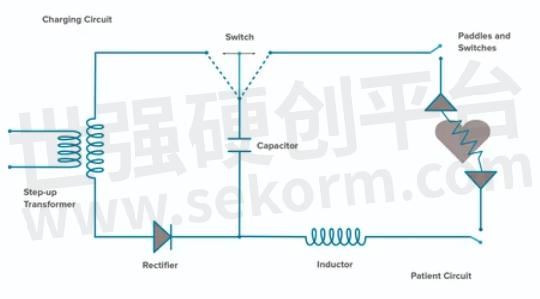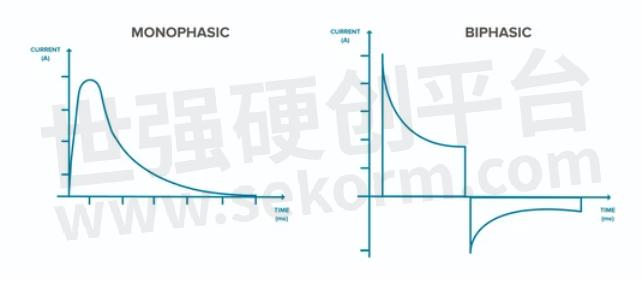Capacitors for External Defibrillators

Defibrillators are designed to deliver electric current to the heart, in the form of a controlled shock to the myocardium, to treat arrhythmias and restore the heartbeat back to normal. Capacitors play an important role in the function of these life-saving devices. Here, we’ll cover the basic components of a defibrillator circuit and explore the role of capacitor selection in defibrillator system design.

In its simplest form, a defibrillator circuit includes a capacitor, transformer, rectifier, and inductor (Figure 1). The transformer serves the charging process by increasing the voltage from hundreds to thousands of volts to deliver the desired energy output. Voltage is converted to direct current (DC) via the rectifier, which allows current to flow unidirectionally to charge the capacitor. Once charged, paddles are applied to a patient’s chest to complete the circuit. The inductor is responsible for maintaining the current flow for several milliseconds to properly treat the patient.

Figure 1. A defibrillator circuit in its simplest form
Defibrillation leverages monophasic or biphasic waveforms to ensure effective treatment with minimal myocardial damage (Figure 2). Biphasic waveforms are more common in modern systems. With this approach, defibrillation delivers a shock in two directions, rather than one, by reversing polarity mid-cycle. Truncated exponential biphasic waveforms discharge the capacitor through the patient with a normal exponential decay that’s reversed using switches on a timing circuit.

Figure 2. Monophasic and biphasic waveforms leveraged in defibrillation
The instantaneous power required for defibrillation isn’t supported by a typical mains electricity supply, so you need an adjustable or step-up transformer to convert mains voltage alternating current (AC) to high-voltage AC. From there, it’s converted to high-voltage DC via the rectifier. Variable voltage step-up transformers allow physicians to select the adequate charge to suit the patient.
The Role of Capacitors in External Defibrillators
Capacitors are responsible for storing a large amount of electrical charge and releasing it quickly into the patient, and effective treatment depends on that charge/discharge process. Capacitor specifications impact pulse size and shape as well as overall system form factor and reliability.
Knowles' Cornell Dubilier brand high-reliability film capacitors for external defibrillators are designed using extensive process validation and rigorous quality testing to ensure a long product lifetime and complete traceability. With a small form factor, they’re ideally suited for portable defibrillation equipment.
- +1 Like
- Add to Favorites
Recommend
- Empower Expands E-CAP Silicon Capacitor Portfolio by Using the Most Advanced Trench Capacitor Technology, making a Breakthroughs in Density and Performance
- What Is a Cylindrical Supercapacitor?
- What are Flying Capacitors?
- Advantages and Disadvantages of Electric Double Layer Capacitors
- Supercapacitor Maintenance Considerations
- Fundamental Capacitor Functions in the World of Electronics
- How Does the Button Fara Capacitor Work?
- Key Features of Button Supercapacitors
This document is provided by Sekorm Platform for VIP exclusive service. The copyright is owned by Sekorm. Without authorization, any medias, websites or individual are not allowed to reprint. When authorizing the reprint, the link of www.sekorm.com must be indicated.





























































































































































































































































































































































































































































































































































































































































































































































































































































































